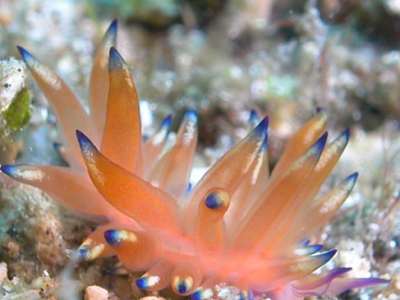
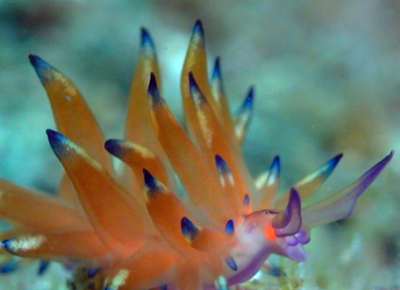
Aplysiopsis sp. 1
Order: SACOGLOSSA
Superfamily: LIMAPONTIOIDEA
Family: Hermaeidae
PHOTO
Lembeh Strait, Indonesia. Depth: 15 m. 28 September 2003. Length: 20 mm. Photos: Francis & Pirjo Pellet
The general shape, and the enrolled thinophores with unequal lobes suggest this is a species of the Hermaeidae. Form the heavy pigmenattion on the body it is most probably a species of Aplysiopsis but to be sure you would have to look at radular teeth. Aplysiopsis has very distinctive teeth ("sabot-shaped" with denticles on cutting edges). Hermaea have more "typical" sacoglossan teeth (blade-shaped, with or without minute lateral denticles), and usually the body is colourless, almost transparent.
Authorship detailsRudman, W.B., 2005 (May 24) Aplysiopsis sp. 1 [In] Sea Slug Forum. Australian Museum, Sydney. Available from http://www.seaslugforum.net/find/aplysiopsp1
Related messages
Re: Aplysiopsis? from North Sulawesi
April 12, 2010
From: Franco De Lorenzi
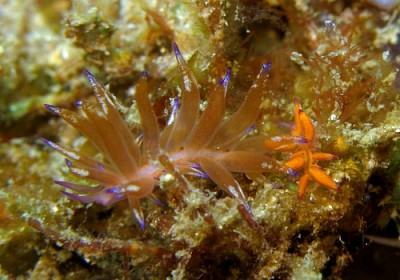
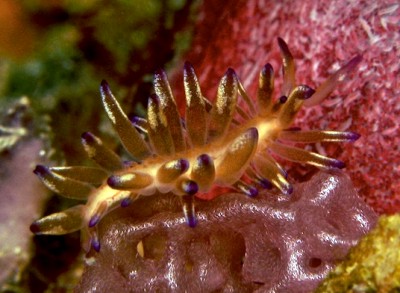
Concerning message #21790:
Dear prof. Rudman,
Concerning to this message in the same place I found both or similar species toghether. So have I to consider them the same speciment?
Locality: Critter hunter - Lembeh Strait, 25 metres, Indonesia, indopacific ocean, 26 august 2009, white sand, broken coral, sponges. Length: 7 mm - 20 mm . Photographer: Franco De Lorenzi.
Thanks for Your help.
Franco
cratena@tiscali.it
De Lorenzi, F., 2010 (Apr 12) Re: Aplysiopsis? from North Sulawesi. [Message in] Sea Slug Forum. Australian Museum, Sydney. Available from http://www.seaslugforum.net/find/23474
Dear Franco,
This is a nice find and certainly is good evidence that the two are colour forms of one species. Interestingly we can see in the juvenile yellow one that it has traces of the white bands on the cerata whih are so typical of the larger specimens.
Best wishes,
Bill Rudman
Re: Aplysiopsis? from North Sulawesi
April 9, 2010
From: Cynthia Trowbridge
Concerning message #21790:
Dear Bill,
I just came across this message about Hermaea vs. Aplysiopsis.
Of the 9 or so described Aplysiopsis species, I have feeding information for 7; all feed on Chaetomorpha, Cladophora, and allies. These are all septate green algal filaments (i.e., they have discrete cells). Next week the Hiranos and I will be presenting a talk at the malacology meetings in Japan on the 4 local Aplysiopsis species as well as the other members of this feeding guild (several Ercolania spp. and Elysia spp.). I do not have any information about A. brattstroemi (Marcus, 1959) or A. elegans (Deshayes, 1864) but would be surprised if they ate red algae (someone would have remarked on this diet as unusual).
Regarding Hermaea spp., they do not all eat red algae but most do. One exception is Hermaea vancouverensis that eats diatoms (Isthmia) that cover macroalgae during the summer in the NE Pacific and Hokkaido. This was discussed on the forum a few years ago [message #15995].
The Hiranos and I have a paper coming out in Veliger that reviews the red algal diets of sacoglossans around the world [e-print will be available soon]. At this point, there are records of Hermaea (most species), Stiliger (some species), and Elysia (some species)that feed on ceramialean red algae. Hermaea spp. have been understudied as they are extremely cryptic and the red algae are taxonomically challenging.
Anyway, the bottom line is that the specimen is probably Hermaea. The odd color is probably due to the breakdown of the red algal chloroplasts...the pigments change from red to peachy-orange as they break down due to low tide exposure during sunny periods.
- Trowbridge, C.D., Hirano, Y.J., & Hirano, Y.M. 2010. Sacoglossan opisthobranchs on northwestern Pacific shores: Stiliger berghi Baba, 1937, and Elysia sp. on filamentous red algae. The Veliger 51: 43-62.
All the best,
Cordially,
Cynthia
sacoglossans@ymail.com
Trowbridge, C.D., 2010 (Apr 9) Re: Aplysiopsis? from North Sulawesi. [Message in] Sea Slug Forum. Australian Museum, Sydney. Available from http://www.seaslugforum.net/find/23425Dear Cynthia,
Thanks for this interesting contribution. It reminded me of a note I made to myself in October 2008, but never follwed it through, concerning message #19041, which also suggests Aplysiopsis sp.1 feeds on filamentous red algae.
I wrote:
"I suspect that Aplysiopsis sp. 1 is a form of Hermaea zosterae, which as I discuss in a separate message is probably a synonym of Hermaea noto [#5195]. Interestingly the evidence suggests that Aplysiopsis sp. 1 feeds on filamentous red algae, which is what species of Hermaea normally feed on"
Before I change Aplysiopsis sp 1 to Hermaea sp 2 I would be interested in your views on this suggestion. Perhaps I should call it Hermaea cf. zosterae?
Best wishes,
Bill Rudman
Aplysiopsis sp. 1 from Sulawesi
October 6, 2008
From: Heidi Hösel
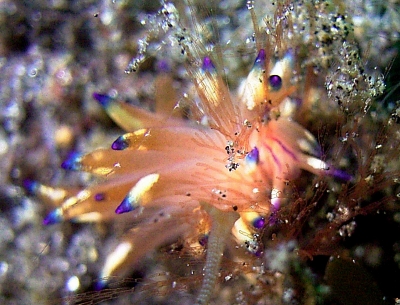
My husband an I found this specimen with characteristic coloration again in the Lembeh strait. The body and main part of the cerata is yellow to orange, the foot is pink. The cerata are thick, end in a iridescent blue to purple apex and exhibit a subapically extending white area. The oral tentacles end in purple tips and also exhibit a subapical white blotch. Unfortunately nobody of us succeeded to get the rhinophores. Two purple lines extend at the dorsal side of the head to the oral tentacles. It seems that the propodial tentacles are reduced. There are some similarities but also significant differences to Facelina rhodopos.
Locality: Hey Nus, Lembeh Strait, N-Sulawesi, about 7m, Indonesia, West-Pacific, 22 August 2006, sandy/silty. Length: about 1cm. Photographer: Heidi Hösel, Hermann Ernicke.
Could you please help us identifying it?
Many thanks in advance
Heidi Hösel
hhoesel@gmx.de
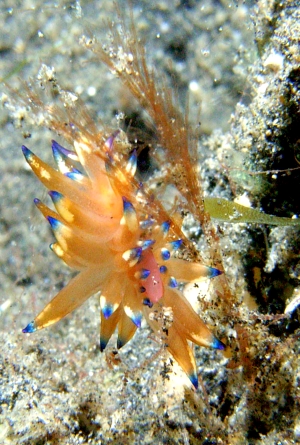
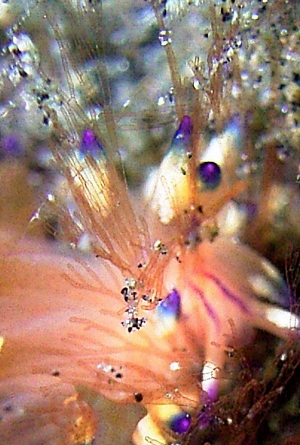
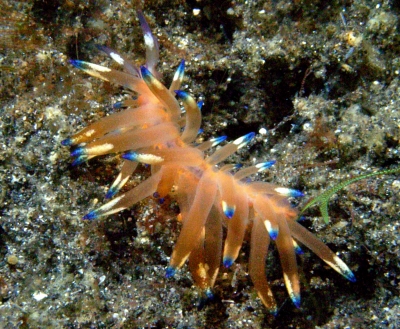
Dear Heidi,
Although in shape and colour this looks like an aeolid it is a sacoglossan which I am calling Aplysiopsis sp. 1 as it is unnamed at present. Interestingly, the filamentous red algae your animal is crawling on, is very similar to that in two earlier mesages [#21790, 18876], suggesting it feeds on red, rather than green, algae.
Best wishes,
Bill Rudman
Aplysiopsis? from North Sulawesi
August 13, 2008
From: Marli Wakeling
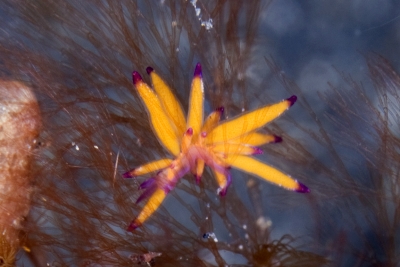
Hi Bill,
Here is a miniscule opistobranch from Lembeh Straight. Its near fluorescent colour is what made it stand out. I first at thought it was a Eubranchus, but now I am wondering if it could be an Aplysiopsis, as it seems to be on algae. The shape and relative length of the cerata are a puzzle, though.
Locality: Lembeh Straight, 30 feet, Sulawesi, Indonesia, Indo-Pacific, 29 July 2008, sand bottom. Length: 4mm. Photographer: Marli Wakeling.
Cheers,
Marli Wakeling
scubamarli@gmail.com
Wakeling, M., 2008 (Aug 13) Aplysiopsis? from North Sulawesi. [Message in] Sea Slug Forum. Australian Museum, Sydney. Available from http://www.seaslugforum.net/find/21790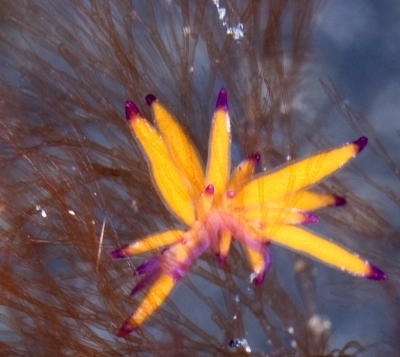
Dear Marli,
I am pretty sure this is the colourful sacoglossan I am calling Aplysiopsis sp. 1. The animal in your earlier message is almost certainly the same species [#8128]. As I discuss in earlier messages on this species, we can't really be sure if this is a species of Hermaea or Aplysiopsis without some anatomical information, especially the shape of the radular teeth. Your photo of it on a filamentous red algae however, tips the balance in favour of Hermaea, as I am pretty sure that genus feeds exclusively on such red algae while species of Aplysiopsis don't. Hopefully Kathe Jensen can confirm that for us.
Best wishes,
Bill Rudman
Aplysiopsis sp. 1 from Lembeh Strait
May 29, 2007
From: Mike Krampf
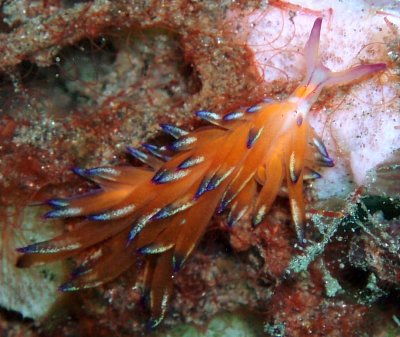
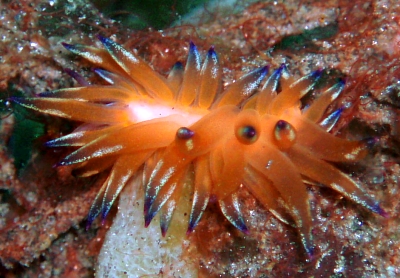
Dear Bill
I found this one on a little area of coral on a muck dive in Lembeh. Your help identifying it is greatly appreciated.
Locality: Lembeh Strait, 50 ft, Indonesia, Celebes Sea, 28 October 2006, Small reef outcrop in a sandy bottom. Length: 3 cm. Photographer: Mike Krampf.
Mike
mtkrampf@yahoo.com
Krampf, M., 2007 (May 29) Aplysiopsis sp. 1 from Lembeh Strait. [Message in] Sea Slug Forum. Australian Museum, Sydney. Available from http://www.seaslugforum.net/find/18876
Dear Mike,
This is an unnamed species I have on the Forum as Aplysiopsis sp. 1. It looks like an aeolid but as you can see in the close-up of the head, alongside, that it only has one pair of head tentacles, which is a pretty good indication that it is a sacoglossan rather than a nudibranch.
Best wishes,
Bill Rudman
Re: Hermaea? from Okinawa, Japan.
May 26, 2005
From: Francis & Pirjo Pellet


Dear Bill,
We think that Hikaru's slug from Okinawa [message #13730] is probably the same we found in Indonesia during our last trip in Lembeh Strait in October 2004 [message #11670 ].
Locality: Lembeh Strait, North Sulawesi , Indonesia. Depth: 25 m. Length: adults 20 mm, juveniles 3 mm. 02-October 2004. Sand. Photographer: Francis PELLET
We thought it is an Aplysiopsis. Altogether we saw four specimen (+ two juveniles) always on the same alga [middle photo], which must be their food . The color of the juvenile is very bright (like fluorescent) orange-red. In fact, what is the difference between Aplysiopsis and Hermaea?
Francis & Pirjo Pellet
pirjo.pellet@free.fr
Pellet, F.& P., 2005 (May 26) Re: Hermaea? from Okinawa, Japan.. [Message in] Sea Slug Forum. Australian Museum, Sydney. Available from http://www.seaslugforum.net/find/13862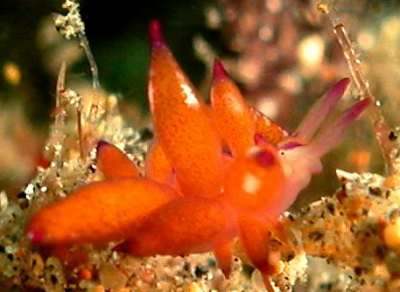
Dear Francis & Pirjo,
I agree they are the same. I'm afraid I had a memory of your photos but couldn't find them when I answered Hikaru's message. As I suggested previously, Aplysiopsis is probably the best genus to place this in.
The general shape, and the enrolled thinophores with unequal lobes suggest this is a species of the Hermaeidae. From the heavy pigmentation on the body it is most probably a species of Aplysiopsis but to be sure you would have to look at radular teeth. Aplysiopsis has very distinctive teeth ("sabot-shaped" with denticles on cutting edges). Hermaea have more "typical" sacoglossan teeth (blade-shaped, with or without minute lateral denticles), and usually the body is colourless, almost transparent.
Best wishes,
Bill Rudman
Re: Hermaea? from Okinawa, Japan.
May 26, 2005
From: Marli Wakeling
Hi Bill,
Concerning this 'Hermaea' [message #13730]:
This looks a lot like two sacoglossans posted in the unidentifieds from the Indo-Pacific, particularly message #11670 and a lot like one I sent in from Lembeh Straight, #8128.
Cheers,
Marli Wakeling
scubamarli@excite.com
Wakeling, M., 2005 (May 26) Re: Hermaea? from Okinawa, Japan.. [Message in] Sea Slug Forum. Australian Museum, Sydney. Available from http://www.seaslugforum.net/find/13874Dear Marli,
As I tell other people - always have a look at the Forum first - and don't forget the unidentified pages! Thanks for drawing my attention to these messages. I had remembered the photos but thought I had seen them in a book or scientific jourrnal. I have put them to gether on a Aplysiopsis sp. 1 page.
Best wishes,
Bill Rudman
Hermaea? from Okinawa, Japan.
May 24, 2005
From: Hikaru Nakada
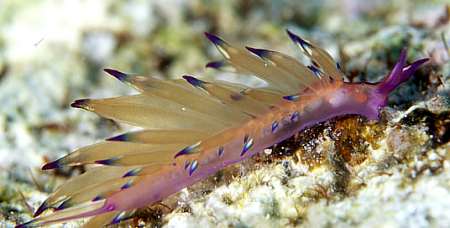
Hello!
Can you please give me the name of this slug. I took the photo at Osaki. (Ishigaki Is. Okinawa, Japan)
Locality: Ishigaki Island, Okinawa, Japan. Depth: 35 meters. Length: 20 mm. 22 April 2005. Sand. Photographer: Hikaru Nakada
Hikaru Nakada.
divernk@m1.cosmos.ne.jp
Nakada, H., 2005 (May 24) Hermaea? from Okinawa, Japan.. [Message in] Sea Slug Forum. Australian Museum, Sydney. Available from http://www.seaslugforum.net/find/13730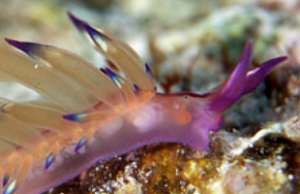
Dear Hikaru,
Although this looks like a colourful aeolid nudibranch. it is in fact a sacoglossan sea slug. If you look at the head, there are only one set of tentacles - the rhinophores - and the eyes are half way between the rhinophores and the cerata. Sacoglossans are often green, taking on the colour of the plants (sea weeds) that they feed on. I think your animal has lost many of its cerata.
It look quite like Hermaea variopicta, but that is a species from the Atlantic. I have a feeling I have seen this species before but I can't find a name for it. Hopefully someone will recognise it for us.
Best wishes,
Bill Rudman
Aplysiopsis? from North Sulawesi
December 12, 2003
From: Francis &Pirjo Pellet


Dear Bill,
On September the 28th we dived again the magic spot for sea slugs "Police Pier" in Lembeh Strait (Indonesia) and found this beautiful slug. We have no idea of it's ID ! Thank you once again for your help that gives us a chance to know better these lovely creatures.
Dive site : Police Pier
length: 20 mm
depth : 15 m
28 September 2003
Best wishes
Francis & Pirjo Pellet
pirjo.pellet@free.fr
Pellet, F & Pellet, P., 2003 (Dec 12) Aplysiopsis? from North Sulawesi. [Message in] Sea Slug Forum. Australian Museum, Sydney. Available from http://www.seaslugforum.net/find/11670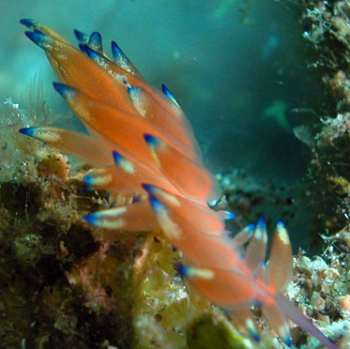
Dear Francis & Pirjo,
I am pretty sure this beautiful animal is a species of sacoglossan. It look quite like an aeolid, but if you look at the middle photo you can see that it only has one pair of head tentacles and they are rolled.
It is possible the same animal that Atsushi Ono has figured in his book on
Kerama Island as "cf Aplysiopsis sp" [p41]. Hopefully Kathe Jensen can give us same advice on this species, which mist be one of the most colourful sacoglossans
Best wishes
Bill Rudman
Hermaea? from North Sulawesi
October 13, 2002
From: Marli Wakeling
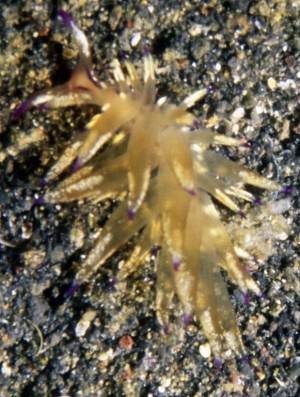
Hi Bill,
This beauty reminded me of the Hermaea I found in British Columbia. However, it was crawling on the sand. There was some algae nearby. At first I thought it was a Janolus, but the rhinophores don't 'add up'. Do you have any idea what it might be?
Location: Hairball, Lembeh Straight, Sulawesi, Indonesia
Date: July 2002
Depth: 40 feet
Length: 2.5 cm.
Photographs: Marli Wakeling
Regards,
Marli
scubamarli@excite.com
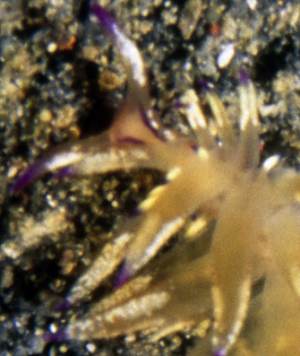
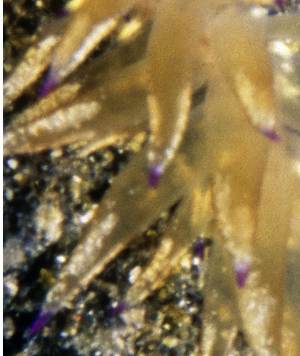
Dear Marli,
I think you are right in thinking this is a sacoglossan. I can only see one pair of head tentacles. I don't recognise it but it has quite a distinctive colour pattern so if it has been described I am sure someone will recognise it for us. I have included a couple of close-ups to show the head and ceratal colouration a bit more clearly. Whether it is a Hermaea depends on its anatomy.
Best wishes,
Bill Rudman
